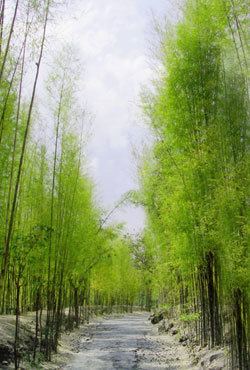Time zone WIB (UTC+7) Area 1,246 km² | Capital Ngawi City Website ngawikab.go.id | |
 | ||
Points of interest Fort Van den Bosch, Kebun Teh Jamus, Monumen Soerjo, Taman Wisata Tirtonirm, Air Terjun Pengantin | ||
Ngawi is a regency (kabupaten) of East Java, Indonesia. Ngawi is well known around the world for its Pithecantropus erectus that was found by Eugene Dubois, a Dutchman. Ngawi is located at the central of East Java province and Central Java province. Ngawi is also the main gate to enter East Java province since there are intersections that connect Surabaya–Madiun–Bojonegoro–Solo–Jogja–Bandung–Jakarta.
Contents
- Map of Ngawi Regency East Java Indonesia
- Climate
- Administration
- Trinil Museum
- Oldest scratch in the world
- References
Map of Ngawi Regency, East Java, Indonesia
Ngawi has the largest city hall in Indonesia, called "Alun-Alun". This includes West Hall and East Hall, which are separated by Merdeka Street. The West Hall consists of football court, volleyball court, and a ceremonial podium near the main mosque. The East Hall consists of a playground area, two tennis courts, basket hall, parking area, futsal court, skater area, and culinary area "the most favorite place visited by Ngawinese". The city hall called Alun-Alun Merdeka is located at the central of the Ngawi city.
Beside that, Ngawi has the largest bus station in Madiun Residency.
Van Den Bosch Fortress was the main historical place to know. It was located at the confluence of the two biggest rivers in East Java, Solo River and Madiun River.
The traditional food from Ngawi and originally from Ngawi are Tahu Tepo, Rujak Tahu, Sate Ayam, and Wedang Cemue. Beside that are also Kripik Tempe, Gethi, and Ledre (made from banana). Ngawi has mainly agribusiness. Its watermelon was well known around the nation.
Climate
Ngawi has a tropical climate (Köppen climate classification Cfa) with hot summers and rainy season. Precipitation is significant throughout the year, but is much heavier around the summer, especially the months of June and July.
Administration
Ngawi Regency is divided into nineteen districts (kecamatan) and 217 villages.
Trinil Museum
Trinil Museum is about 15 kilometers from Ngawi city and near of Bengawan Solo River. The museum collected about 1,500 fossils from one million years of age and in 2013 up to 500 fossils have still not yet been identified. In the late 19th century Eugene Dubois found Pithecantropus eretus in the Trinil area, and it has made Darwin's evolution theory is not applicable, because humans are created by humans also.
Oldest scratch in the world
Researchers found in Trinil site that scratch at Pseudodon vondembuschianus trinilensis plain water clam shell aged 500,000 years is the oldest scratch in the world, although the scratch maybe not an art, but the zig-zag scratch obvious that the scratch is human made. The clam shell has been found in 1896, but the zig-zag scratch is yet understood in 2014.
